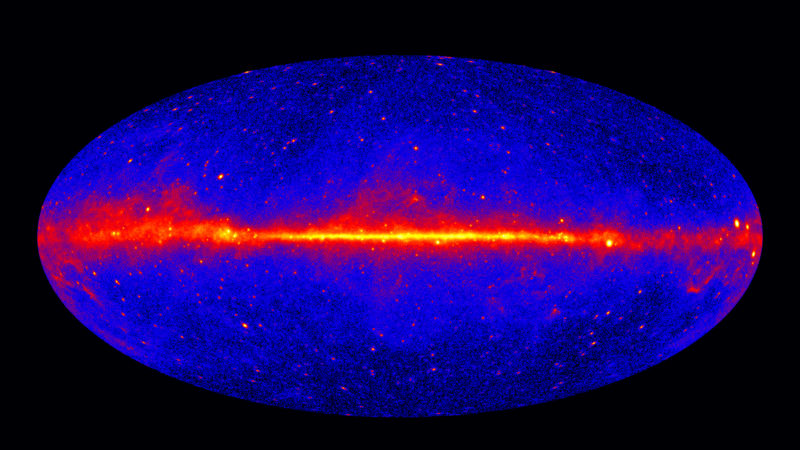Antimatter is rare in this Universe, but the Universe is a pretty big place, so even small quantities can add up fast. In our galaxy alone, there's a steady bath of radiation that indicates positrons are constantly running into their electron anti-partners and annihilating them. Over something the size of a galaxy, that means there are lots of the positrons around. Estimates have it that 9.1 trillion kilograms of antimatter are being destroyed each second.
Where's it all coming from? We don't really know, but candidates have included everything from dark matter particles to supermassive black holes. A new paper suggests a relatively unexciting source: a specific class of supernova that produces lots of radioactive titanium, which decays by releasing a positron.
Mystery
While positrons are produced by radioactivity here on Earth, they run into normal electrons almost instantly, a collision that annihilates both and releases an energetic photon. The interstellar material in space is so sparse, however, that it's thought that positrons typically travel for over 100,000 years before running into anything. That's long enough to blur out any individual sources and turn a single burst of positron production into a slow background of annihilations. So even if there are objects that produce positrons, we'd have a hard time spotting them.
There seemed to be an excess of positrons near the bulge at the center of our galaxy. Since the bulge has less of our galaxy's stars than the galactic disk, that implied that stars probably weren't involved in their production. That's one of the reasons dark matter annihilations seemed to be an appealing explanation. But the photons that reach us from the annihilations don't have much additional energy beyond that produced by the annihilation itself. This implies that the positrons are relatively low-energy, which would seem to rule out dark matter collisions, as well as a variety of other exotic sources.
But, according to the authors of the new paper, the ESA's INTEGRAL mission suggested there are more positrons coming from the disk than we thought. And lots of the positrons coming from the galactic bulge appear to be generated at its central black hole. So, it appears that the production of positrons by the disk and bulge are roughly in proportion to the number of stars there. So a stellar source is back on the table.
And anti-mystery
How can a star that's filled with matter start producing antimatter? By blowing up. Supernovae produce lots of heavier elements, some of which are radioactive. And certain types of radioactive decays release positrons. In fact, three different elements known to be produced in supernovae can do so: 56Ni, 44Ti, and 26Al.
56Ni has the shortest half life of these decays with a half life of only six days. Because of this rapid decay, however, most of the positrons are released while the supernova debris are still relatively dense. As a result, they end up annihilated within the debris, contributing to the brightness of the supernova. So that's off the table.
26Al, in contrast, has a half life of over 10,000 years, enough to get it well clear of the supernova. Because it typically decays away from other radiation sources, we can actually detect the photons produced as it decays, which gives us a measure of how many positrons must be produced. The number we get is only 10 percent of the positron annihilation rate, so aluminum is off the table as well.
That leaves us with 44Ti, which has a half life of 60 years. That's long enough for supernova debris to thin out before the positrons are produced. And we can spot its decay in the debris of supernovae produced by collapsed stars. Again, however, we can track its decay using the photons released, and there isn't enough titanium in these supernova remnants to account for the galaxy's positrons. It would appear titanium has been eliminated as well.
But the authors find a way to put it back in play. There's a relatively rare class of supernova (called SN 1991bg-like) that can produce unusually high amounts of titanium. These supernovae occur when two moderate sized stars end up close enough to share a common envelope. One ends up with enough material to turn into a carbon-oxygen white dwarf; the second ends up as a ball of nearly pure helium. When the two stars later collide, models suggest that the resulting explosion should produce a lot of intermediate mass atoms, like calcium, chromium, and—critically—titanium.
We've seen titanium decay in the aftermath of these explosions, and it's estimated that the rate of these explosions are enough to supply a steady stream of radioactive titanium. The key question is whether it's enough to provide the 90 percent of the positrons that aren't produced by aluminum. Based on simplified models of fusion reaction chains, it could. But the authors call for people who run sophisticated supernova models to run simulations of this particular type of explosion.
This isn't the final word on our galaxy's antimatter, but it's a plausible explanation that's amenable to future testing, through both computer models and observations. In the meantime, an explanation involving physics we already know about has got to be preferred over anything that's purely theoretical.

